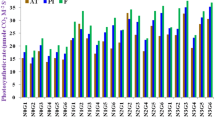Summary
Rice plant of medium duration, grown under low nitrogen supply (10 p.p.m.), shows two peak periods ofpartial efficiency for nitrogen, when nitrogen taken up by the plant is most efficiently utilized in increasing grain yield. First such period occurs at the tillering stage and the second at flowering, between the boot and milk stages.
Nitrogen taken up by the plant between tillering and ear-initiation plays role in increasing tiller and panicle number per plant. During panicle development, from ear-initiation to flowering, nitrogen taken up increases number of filled grains per panicle and, after flowering, it increases effective 1,000 grain weight. The first period of maximumpartial efficiency is, therefore, for increasing tiller number and the second for increase of panicle weight,
If, however, the plant is grown at high levels of nitrogen (60 p.p.m.) from the start, nitrogen taken up during the vegetative stage, up to ear-initiation, is stored in the body of the plant and is used in the later growth and development, even if nitrogen supply is cut off later. High nitrogen supply, after ear-initiation, has detrimental effect on growth and decreases grain yield because of decrease in number of filled grains per panicle and 1,000 grain weight. Chaffiness of panicle, under this condition, also markedly increases and plant becomes more susceptible to neck infection due to blast.
The authors are indebted to Mr. R. L. M. Ghose, Director, Central Rice Research Institute, Cuttack, for suggestions and improvement in the text of the paper.
Similar content being viewed by others
References
Gericke, W. F...Soil Sci., 1930,29, 207.
Ishizuka, Y...J. Agri. Chem. (Japan), 1933,8, 17.
Kasugai, S...J. Sci. Soil and Manure (Japan), 1939,13, 669.
Kimura, J. and Chiba, H... Ibid., 1943,17, 479.
Mitsui, S...Inorganic Nutrition Fertilization and Soil Amelioration for Lowland Rice, Yokendo Ltd., Japan, 1955.
Osugi, S. and Aoki, M...Agr. and Hort., 1938,13, 6.
Ozaki, K. and Mitsui, S...J. Sci. Soil and Manure (Japan), 1950,21, 86.
Tanaka, A., Patnaik, S. and Abichandani, C. T.Proc. Ind. Acad. Sci., 1958a,47 B, 140.
—————.. Ibid., 1958,48 B, 14.
Author information
Authors and Affiliations
Additional information
Communicated by Mr. R. L. M. Ghose,f.a.sc
Rights and permissions
About this article
Cite this article
Tanaka, A., Patnaik, S. & Abichandani, C.T. Studies on the nutrition of rice plant (Oryza sativa L.). Proc. Indian Acad. Sci. 49, 207–216 (1959). https://doi.org/10.1007/BF03052043
Received:
Issue Date:
DOI: https://doi.org/10.1007/BF03052043




